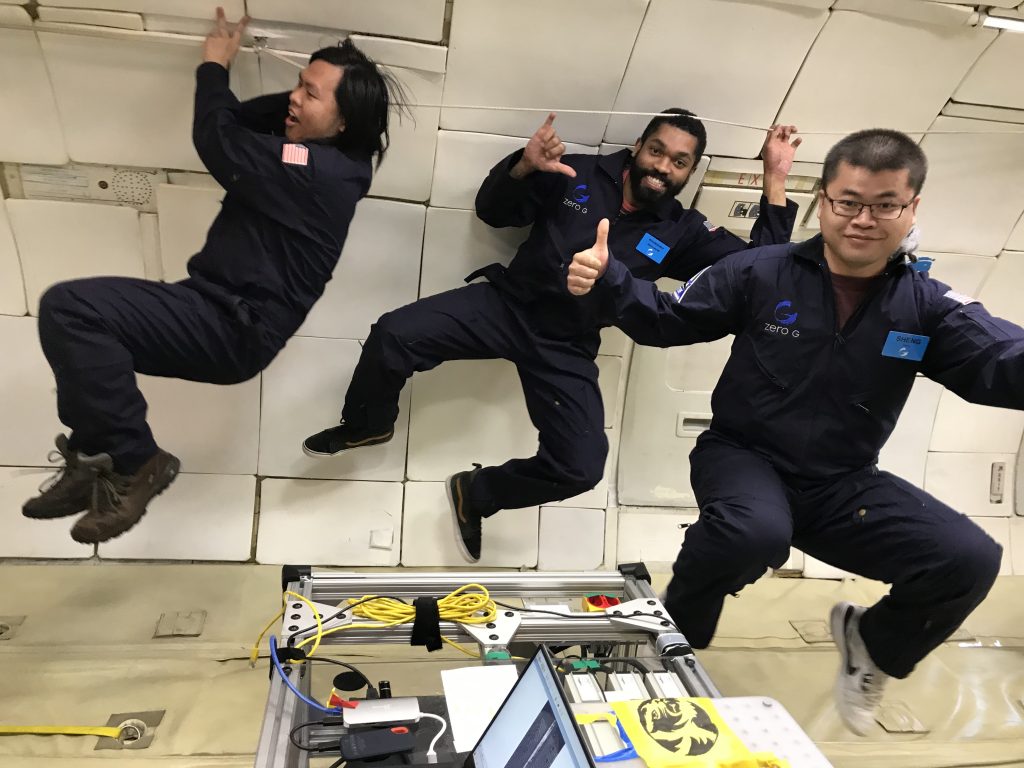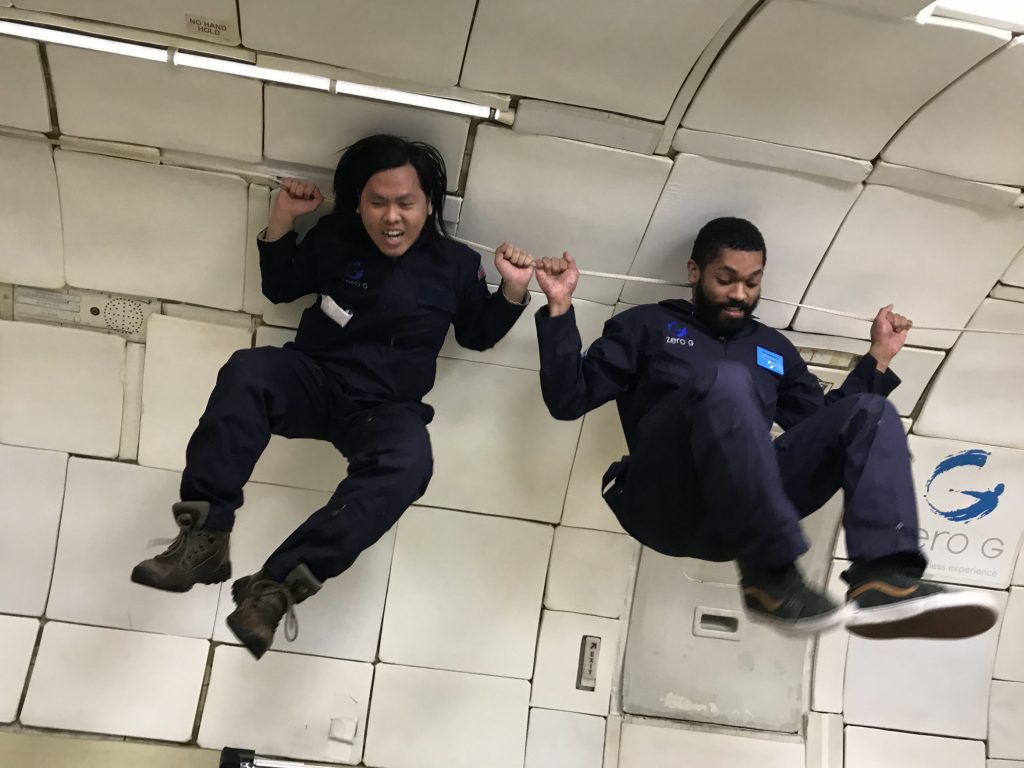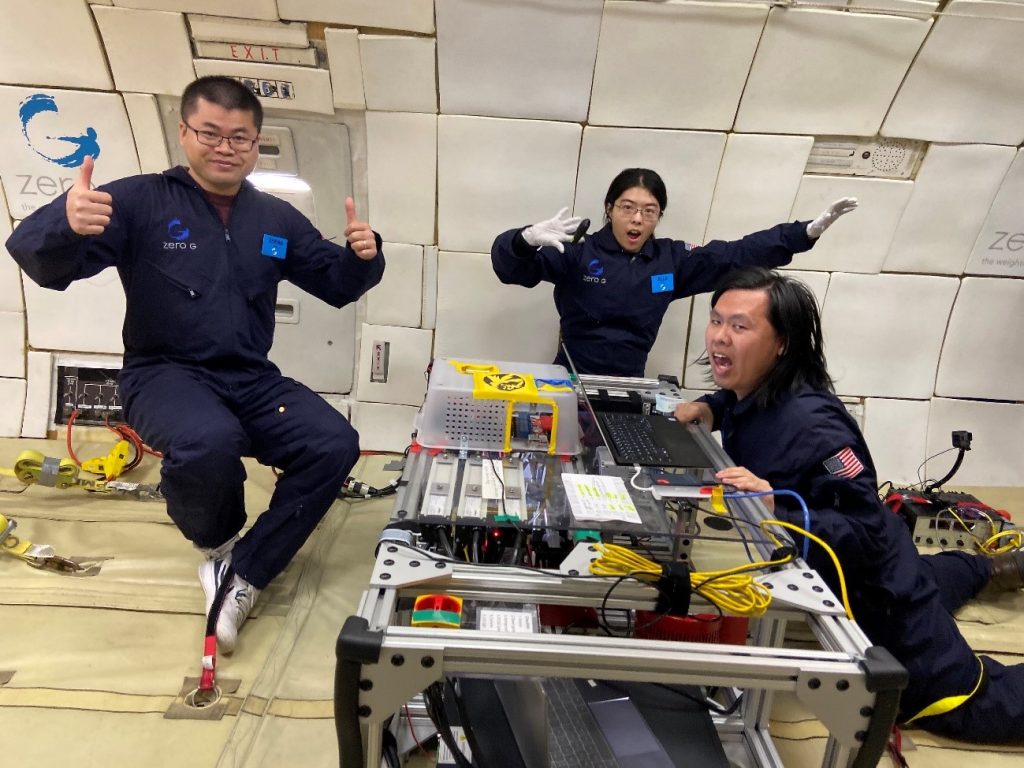December 19, 2019

Robin Pham, Robert Enyard and Sheng Wang getting comfortable in a zero gravity environment aboard Zero Force One.
A research experiment by a Mizzou Engineering team in a zero-gravity environment could lead to the development of an efficient method of harvesting water in space. With funding from NASA, the project aims to contribute to future missions to Mars and beyond and for the crew members on the International Space Station (ISS). From William and Nancy Thompson Professor Chung-Lung (C.L.) Chen’s research lab, Assistant Research Prof. Sheng Wang and recently graduated Ph.D. student Run Yan led the team aboard the G-FORCE ONE last month near Orlando, Florida. They were joined by three other enthusiastic students in the Department of Mechanical and Aerospace Engineering (MAE).
Yan explained the team’s technique.
“We found that using the device developed in our lab, we observed a good enhancement of water harvesting, and we predicted that it would also work in zero gravity,” she said. “On the ISS, they regularly need to adjust the humidity inside their living and working space. At times, they may also want to harvest water. So, if our device works in zero-g, the space station crew could make some modifications to achieve these tasks more energy efficiently.”
Yan said the team had some success using their electrowetting method – applying an electric field to a microfabricated structure to create condensation on the surface area. “When we turned on our device, we saw more water droplets on the surface compared to the normal condensation that would occur,” she said.

Run Yan, Sheng Wang, Robin Pham, Robert Enyard and Jack Kellett, suited up and ready to fly.
Another potential application of the team’s method to increase water harvesting would be to grow plants in space.
“With this method, we can direct the path of water droplets, so for plant growth, for example, we can guide the water right to the root system, so it is more efficient,” Wang said.
MAE graduate student Robin Pham said their device may also significantly lower the cost of harvesting water in space.
“On the ISS, they already have a system to harvest water, but it is a centrifugal system. Thus, it costs a lot of money and energy to harvest water in space as of now,” he said.
Learning to Fly

Sheng Wang, Run Yan, Robin Pham, Robert Enyard and Jack Kellett with their experimental device aboard the specially-modified Boeing 727 called G-Force One.
To test their device in zero-gravity, the team made arrangements with the Zero Gravity Corporation, a privately held space entertainment and tourism company whose mission is “to make the excitement and adventure of space accessible to the public.” The team prepared for their flight campaign since October 2018 and encountered several delays—getting Federal Aviation Administration certificates approved and other logistical issues, so the original flight scheduled for this July did not happen until November. Team members had various reactions to their experiences in zero-gravity, but they all agreed the first trip was the most disorienting.
“The first time I experienced zero-g I felt very strange, like I’m not controlling my body, and everything is weird,” Yan said. “The second day we started with simulated Martian gravity, which is one-third of Earth gravity, and then lunar, which is one-sixth before going to zero-g, which helped me adjust a little easier.”
Pham says he could not move each time the weightless environment was created aboard the Zero Gravity Corporation’s specially modified Boeing 727.
“At the first few zero-g’s, I just held onto the experiment rig. And I had to remind myself to breathe every time the simulation started,” he said.
MAE graduating senior Robert Enyard said he was tasked with installing and monitoring the experimental systems, and at times, acted as the team’s cameraman. He also said he felt more comfortable on the second day.

Robin Pham and Robert Enyard learn to adjust to weightlessness during their zero-gravity test flights.
“I was pretty anxious the first day because I had never been in that situation, but on the second zero-g flight I talked to our coach and she felt comfortable letting me go over to the wall to float up,” he said. “So, I am an amateur zero-g cameraman. I floated near the ceiling a couple of times but the coach caught me.”
Wang and team member Jack Kellett, also a MAE graduating senior, did not fare as well in a weightless environment.
“Run, Robin and Robert did a very good job, but Jack and I had a little trouble—we got a little airsick,” Wang said. “After I rested for a while and saw those three were also stressful, I thought, ‘I need to support my team,’ so I got up and told the coach I was okay but to give me a bag just in case.”
“I was not fine on that first day,” Kellett said. “I turned out to be sick on top of experiencing zero gravity; I had a fever the night before and didn’t realize it that until after that first day. I got about five minutes in zero gravity, which were still the best five minutes of my life, and then I spent the rest of the time in the back of the plane.” Kellett was grounded on the second day so he could recover from his illness.
Yan says team members also had to learn to cope with hypergravity; between the zero-g sessions, the G-FORCE ONE flight profile creates moments of hypergravity, and then back to zero-g. Team members describe it as being on a rollercoaster.
“I remember preparing to take photos in hyper gravity and the camera was like a heavy stone in my hand and it was very hard to get up off of the floor of the plane,” Yan said.

Sheng Wang, Run Yan and Robin Pham work on their water harvesting experiment in zero gravity.
Open Positions in the Next Flight
The Mizzou Engineering team conducted their zero-gravity experiments at a facility near Orlando, Florida, and the next zero-gravity flight is scheduled for March 2020 in Fort Lauderdale, Florida. Wang says the team needs two to three more flyers to make the trip in March since some of the team members are graduating this semester. Students from all engineering majors are welcome to apply. He added they might need help from a student majoring in electrical engineering because they want to automate some of the components in their test device in the zero-g environment.
Kellett encourages students to consider making the trip, despite his less than successful experience.
“You become an engineer to solve problems, and I guarantee if you go on this trip you are going to have some really interesting problems to solve in a very short period of time,” he said. “And you might get a chance to go up into microgravity—how can you possibly turn that down?”
Chen says the team would like to extend their gratitude to the NASA program manager Earl Adams, MAE department chair Noah Manring and Associate Dean of Academic Programs and Student Success Hani Salim for their strong support. The team also appreciates the College’s Director of Facilities Ron Monson for helping the team arrange their trip; electronics technician Mike Harlow, who helped the team deal with electronics problems while preparing for the flight; and Thomas McClure for his contribution to testbed development.
Their project has been on-going for more than a year, engaging with two MAE Capstone groups and many passionate engineering students.




